Using Polymers to Enhance Solubility of Poorly Soluble Drugs
The authors demonstrate how melt-extrusion and spray-drying methods can help to prepare solid dispersions of poorly soluble drugs using Eudragit polymers.
The number of poorly soluble drugs continues to increase. Forty percent of drugs currently on the market exhibit poor solubility, and 90% of active ingredients in development are poorly soluble (1). The interest in finding methods to increase solubility and dissolution rate is therefore growing. Industry uses various approaches to achieve these goals, many of which can be found in the literature.
Some methods manipulate the structure of the drug (e.g., they incorporate certain groups to generate a prodrug or the creation of different salts with higher solubility) (2). Other methods are physical such as decreasing the drug's particle size (e.g., micronization or nanosizing, crystal habit modification, complexation with cyclodextrins, generation of polymorphic forms or solubilization) (3). The most widely used approach is to form solid dispersions of the drug in a carrier, where the drug is present as amorphous or crystalline regions in a carrier, or—more preferable with respect to stability—the drug is dissolved molecularly in the polymer. In either case, solubility can be enhanced because there is no lattice energy to overcome to dissolve the drug. After the carier is dissolved, the drug is released to media already in a dissolved state. Besides other polymers, polymethacrylates such as Eudragit (Evonik Röhm GmbH, Darmstadt, Germany) are amorphous and more ideal for preparing solid dispersions.
Solid dispersions can be prepared using various techniques. Among these, spray-drying and melt extrusion have proved to enhance solubility. Both techniques have advantages as well as limitations. In the case of a drug with a high melting point, spray-drying is the method of choice because the temperature applied in the melt extruder is limited by the carriers' thermostability. Another limitation to melt extrusion is its application for temperature-sensitive drugs. In these cases, spray-drying could be better applied. One limitation to spray-drying is that, in some cases, there is no solvent available to dissolve the polymer and the drug. In this situation, melt extrusion has an obvious advantage. Organic solvents can lead to problems such as residual solvents in the product, lack of security during production, and environmental issues.
A previous article described the increase in dissolution from melt extrudates containing Eudragit E, Eudragit NE 30D, and felodipine (4). Eudragit NE 30D is a water-insoluble polymer conventionally used for sustained-release applications in coatings, matrix systems, and melt extrusion. In small portions, Eudragit NE 30D can be used as stabilizing agent. It swells and is dispersed as fine particles in the media, seperating the drug particles from each other and hindering precipitation.
This article compares these results with a similar formulation, prepared by spray-drying. The authors discuss how melt extrusion and spray-drying can be used to prepare solid dispersions of poorly soluble drugs with Eudragit polymers. These solid dispersions show comparable results in dissolution rate, X-ray powder diffraction (XRPD), and differential scanning calorimetry (DSC).
Materials and methods
Materials. Felodipine for spray-drying was purchased at Shiono Chemical Co. (Tokyo) for melt-extrusion trials in Zhejiang Yiyuan, China. Carbamazepine was a gift from Evonik (Dossenheim, Germany). The authors also used Eudragit E and Eudragit NE30D (Evonik Röhm GmbH, Darmstadt, Germany) and ethanol (Wako Pure Chemical Industries, Osaka, Japan).
Spray-drying. Eight-five percent of 5% Eudragit E PO, 5% Eudragit 30D, and 10% felodipine were dissolved in ethanol (95%). The organic solution contained 14% of solid. Ten percent carbamazepine and 90% Eudragit E PO were dissolved in ethanol (95%) with a solid content of 6%. The spray-drying process was conducted with a Mini Spray-Dryer B-290 (Buech, Tokyo). Operational conditions are described in Table I.
XRPD was carried out on a Mini-Flex, DSC was carried out on a Thermo plus 2–DSC 8230 (Rigaku, Tokyo), and the scanning electronic microscope (SEM) used was a JSM–6360LV (Jeol, Tokyo).
Solubility was measured with high-performance liquid chromatography (HPLC). The drug, the physical mixture, or the spray-dried sample was dispersed in 0.1N hydrochlorid acid (pH 1.2); the dispersion was homogenized with ultra sonic vibration for 10 min and filtered. Solutions with felodipine were diluted with the mobile phase acetonitrile/0.01 M phosphate buffer pH 4.5 (70/30). The wavelength was set to 237 nm and the flow rate was 1 mL/min. Dissolution testing was performed with a paddle apparatus (DT610, Jasco, Tokyo), at a rotation speed of 100 rpm. The authors used 900 mL of 0.1N hydrochlorid acid (pH 1.2) and added samples equivalent to 18 mg of felodipine or 360 mg of carbamazepine. The wavelength was set to 237 nm for felodipine and 285 nm for carbamazepine.
Melt extrusion. Solid dispersions containing felodipine (melting point=145 °C), Eudragit E, and Eudragit NE 30D (10%/85%/5%) and solid dispersion with 10% carbamazepine (190 °C) and 90% Eudragit EPO were prepared by melt extrusion on a twin-screw extruder (Micro 18 GL Pharma, Leistritz, Nürnberg, Germany). The temperature profile of the felodipine sample was between 70°C and 160°C, the screw speed was set at 200rpm, the feeding rate of the solids at 0.7 kg/h and Eudragit NE 30D was dosed with a hose pump. For the carbamazepine sample, the temperature was between 70 °C and 200 °C, the screw speed was 150 rpm, and the feeding rate of the solids was set at 0.5 kg/h. The extrudate was pushed through an orifice, collected on a conveying belt, and granulated. The granules were milled to 250 µm.
XRPD was carried out on an X'Pert Pro MPD Diffraktometer (Panalytical, Almelo, The Netherlands), DSC was done with a Pyris 1 DSC (Perkin Elmer, Waltham, MA). Dissolution testing was performed with a paddle apparatus (DT 700, Erweka, Heusenstamm, Germany) at a rotation speed of 100 rpm. The authors used 500 mL of simulated gastric fluid sine pepsin (SGFsp) at a 1.2 pH and added samples equivalent to 10 mg of felodipine or 200 mg of carbamazepine. The concentration of felodipine was measured with HPLC using acetonitile/phosphate buffer pH 3/methanol 40/40/20 % (v/v/v) as a mobile phase. The wavelength was set to 362 nm and the flow rate was 1 mL/min. The concentration of carbamazepine was measured with an ultraviolet spectrometer at a wavelength of 285 nm.
Preparation of physical mixture. Physical mixtures were prepared by blending the substances for 10 min at 40 rpm in a double-cone mixer (Erweka, Heusenstamm, Germany). For the physical mixture containing Eudragit NE 30D, the dispersions were dried to obtain a solid.
Results
For the spray-dried samples, the residual solvent content was measured by loss on drying with infrared (IR) spectroscopy. Less than 0.95 wt% of residual ethanol content in the spray-dried sample was found and presumed not to influence XRPD, DSC, or stability.
Spray-drying and melt extrusion with felodipine. In a previous study, 10% of felodipine was identified as the optimum drug load with respect to dissolution (3). Spray-dried samples, therefore, were produced with a 10% drug load and compared with the results of an extrudate with the same formulation used in a previous study (3). Spray-dried and extruded samples were analyzed with DSC and XRPD to evaluate the crystallinity of felodipine in the samples. In XRPD (see Figure 1), no typical peaks referring to felodipine could be observed in the spray-dried sample or in the extrudates. In comparison, the corresponding physical mixture showed peaks in XRPD at 10.23 (2θ), 10.88(2θ), 16.6(2θ), 20.5 (2θ) und 23.7(2θ), where θ is defined as the incident angle of the X-ray (i.e., the angle between the incident X-ray and the plane of the sample). Because Eudragit polymers are amorphous and the positions of the peaks are equal to pure felodipine, these peaks are clearly related to pure felodipine. Both methods lead to a formation of a solid dispersion of felodipine, Eudragit E and Eudragit NE 30 D.

Figure 1 (All figures are courtesy of the authors.)
These results were confirmed with DSC. The DSC runs of pure felodipine, a physical mixture, and the spray-dried and extruded samples can be seen in Figure 2. In the physical mixture and in the pure felodipine, a melting peak was detected, whereas in the spray-dried sample and in the extruded sample, no melting peak was observed. Only one glass transition temperature (Tg) could be seen. The Tg value in the melt-extruded sample is below the Tg value of the pure polymer, meaning felodipine has a slightly plasticizing effect on the polymer. The appearance of a single Tg is an indication for the formation of a glassy solution where the drug is dissolved in the polymer.

Figure 2
The formation of a solid glassy solution leads increases the dissolution rate and apparent solubility of felodipine. In Figure 3, the solubility of the spray-dried sample is compared with the solubility of pure felodipine and the physical mixture. For felodipine, no solubility was detected because the value was below the detection limit. The physical mixture increased in solubility (40 µg/mL), because of to the wetting properties of Eudragit. The spray-dried sample increased the solubility of felodipine 8.5-fold to 340 µg/mL. This tremendous increase in solubility is caused by the formation of a solid dispersion. In Figure 4, the SEM picture of pure felodipine and the spray-dried powder can be seen. Pure felodipine appears as cubic crystals; in the spray-dried powder, no felodipine crystals are observed.
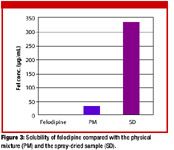
Figure 3
In Figure 5, the dissolution profiles of the extrudate and the spray-dried powder are compared with those of pure felodipine in acidic media. Dissolution of extrudates was described in a previous study (4) and is used for comparison with the spray-dried sample. Crystalline felodipine, as expected, shows nearly no dissolution because its solubility in 0.1N hydrochlorid acid (pH 1.2) is very poor (1 mg/mL).

Figure 4
The spray-dried sample shows a clear increase in dissolution rate comparable with the extrudate. The combination of the two polymers in spray-drying and in melt extrusion generates a product with a high initial release, based on Eudragit E and a stabilization of the profile with Eudragit NE 30 D. Eudragit E is known to increase the dissolution rate of poorly soluble drugs (5).
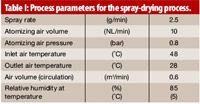
Table I
The average difference for all time points between dissolution curves of the spray-dried sample and the extrudate was less than 10%, meaning the dissolution profiles were similar. Although the dissolution tests were performed under different conditions and only three units per test were used, the similarity factor (f2) calculation was applied, leading to a f2 value of ~70, which proves the similarity of the dissolution curves.
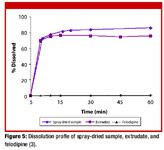
Figure 5
Spray-drying and melt extrusion with carbamazepine. Spray-dried and melt-extruded samples containing Eudragit NE 30D E and carbamazepine were analyzed with XRPD and dissolution testing. Neither samples exhibited crystalline peaks in XRPD analysis (see Figure 6), thereby showing that an amorphous state of carbamazepine is likely. For the pure carbamazepine, crystalline peaks were observed corresponding to the polymorphic modification stable at room temperature. The physical mixture also showed crystalline peaks at 13.14(2θ), 15.36(2θ), 15.94(2θ), 17.18(2θ), 19.6(2θ), 25.02(2θ), and 27.42(2θ), corresponding to carbamazepine crystal of modification 3.
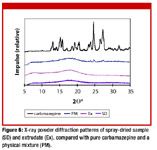
Figure 6
In Figure 7, the dissolution profile of the spray-dried sample and the extrudate are compared with the physical mixture. For both solid dispersions, a 100% release was observed. Eudragit E dissolved rapidly in the acidic media and exposed carbamazepine already in a dissolved state. The spray-dried sample demonstrated a complete release within the first 5 min, whereas the release from the melt-extruded samples was slightly slower, reaching a complete release after 20 min. During dissolution, the powder in the melt-extruded samples agglomerated at the beginning, slightly retarding the release of the drug. In addition, the particle sizes of the milled extrudate were larger than those of the spray-dried sample.

Figure 7
Stability results for melt-extruded samples are available and showed a stable profile over a storage period of 6 months at elevated conditions (see Figure 8). The same results can be expected of the spray- dried samples if the same polymer is used. Stability of spray-dried samples is currently under investigation. Overall, Eudragit E is a suitable carrier for increasing the dissolution of carbamazepine and stabilizing a drug during storage.
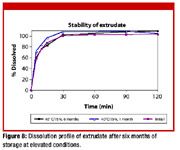
Figure 8
Conclusion
Two model drugs were seleceted and formulated with Eudragit using spray-drying and melt extrusion techniques. XRPD and DSC were used to characterize the obtained solid dispersion. Spray-dried and extruded samples showed a high increase in solubility for both drugs. The profiles were comparable, meaning that both techniques can be used to increase the drug's dissolution rate. Each method has advantages. In the case of a high melting drug, spray-drying is the method of choice. On the other hand, because melt extrusion is a solvent-free process, no drying is required and one can avoid the problem of having to find a suitable solvent. The melt-extrusion technique seems not to be crucial for preparing a solid dispersion. A more important prerequisite is the miscibility of polymer and drug. Both poorly soluble drugs were miscible with Eudragit, demonstrated by the appearance of only one Tg in DSC. Non-miscible systems are likely to recrystallize and show stability problems. Miscible systems form a more stable solid dispersion as the drug is dissolved in the polymer.
Eudragit polymers are well known and widely used in coating and matrix applications. This study showed that Eudragit polymers are also suitable to succesfully increase the solubility of poorly soluble drugs in vitro by forming stable solid dispersions with the drug. because of to the increase in solubility, an increase in bioavailability in vivo will occur. Furthermore, the study shows that both melt extrusion and spray-drying can be used to obtain solid dispersions with Eudragit polymers and drugs leading to comparable results.
Kathrin Nollenberger* is the technical manager of melt extrusion and Andreas Gryczke is the technical marketing manager of technology commercialization, both at Evonik Röhm GmbH, Kirschenallee, 64293 Darmstadt, Germany, tel. +49 6151 18 4292, fax +49 6151 18 3249, Kathrin.nollenberger@evonik.comTakayuki Morita is the technical service manager and Tatsuya Ishii is a research scientist on technical service, both at Evonik Degussa Japan Co.
*To whom all correspondence should be addressed.
References
1. L. Benet et al., "Predicting Drug Absorption and the Effects of Food on Oral Bioavailability," Bulletin Technique Gattefosse 99, 9–16 (2006).
2. G.L. Engel et al., "Salt Form Selection and Characterization of LY333531 Mesylate Monohydrate," Int. J. Pharm.198 (2), 239–247 (2000).
3. C. Leuner and J.Dressman, "Improving Drug Solubility for Oral Delivery Using Solid Dispersions," Eur. J. Pharm. Biopharm.50 (1) 47–60 (2000).
4. K. Nollenberger and S. Brühne S., "Pair Distribution Function X-ray Analysis Explains Dissolution Characteristics of Felodipine Melt Extrusion Products," J. Pharm. Sci.98 (4) 1476–1486 (2008).
5. Biovail Technologies Ltd., "System for Rendering Substantially Non-Dossoluble Bio-Affecting Agents Bio-Available," US patent US 6391338± (May 21, 2002).
What would you do differently? Email your thoughts about this paper to ptweb@advanstar.com and we may post them on PharmTech.com
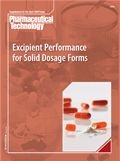
Drug Solutions Podcast: A Closer Look at mRNA in Oncology and Vaccines
April 30th 2024In this episode fo the Drug Solutions Podcast, etherna’s vice-president of Technology and Innovation, Stefaan De Koker, discusses the merits and challenges of using mRNA as the foundation for therapeutics in oncology as well as for vaccines.
Drug Solutions Podcast: Applying Appropriate Analytics to Drug Development
March 26th 2024In this episode of the Drug Solutions Podcast, Jan Bekker, Vice President of Business Development, Commercial and Technical Operations at BioCina, discusses the latest analytical tools and their applications in the drug development market.